Ride Sharing Electric Scooters in Bangkok
Last month I wrote a blog post called My first experience with an electric scooter in Bangkok. It stirred up quite a bit of interest, both on my blog post and my Facebook page. I ended by saying that I was seriously interested in buying an electric kick scooter but I needed to give it some more thought. Would I really use it that much? Can I use it on public transport? And how safe is it? My concern was that I would buy it and then only use it a few times. Which made me think that I should consider the alternative of renting one. Which lead me to the ride sharing service in Bangkok provided by SCOOTA. Would it make more sense to rent an e-scooter as and when I wanted to use one?
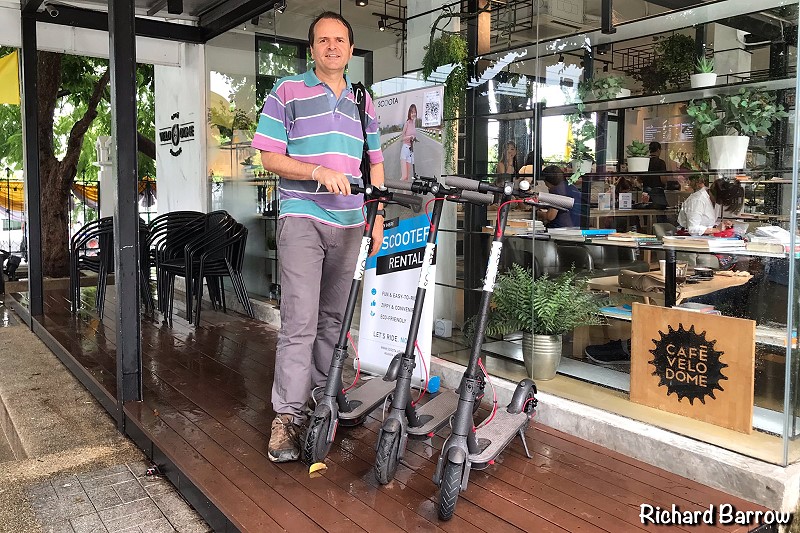
There are several ride-sharing operators in Bangkok. The first one I had heard about was an orange e-scooter owned by a company called Neuron. All you had to do is install a free app to find the nearest scooter and then scan the QR-CODE on the handlebar. Then, when you finished your ride, you could just leave it where you liked for the next customer. Obviously convenient, but not so good for pedestrians or owners of the buildings if the e-scooter was discarded in a way that blocked access. Most of the comments I had read about Neuron were negative because of the way the scooters were abandoned. Which is why a new Thailand based company called SCOOTA caught my attention. In contrast, they have parking stations around the city. These are at places like restaurants and hotels. So, there are people looking after them. Like Neuron, you download and install the app to find your nearest scooter. The app also says how many scooters are presently available at each station. I started my test run at Cafe Velodome.
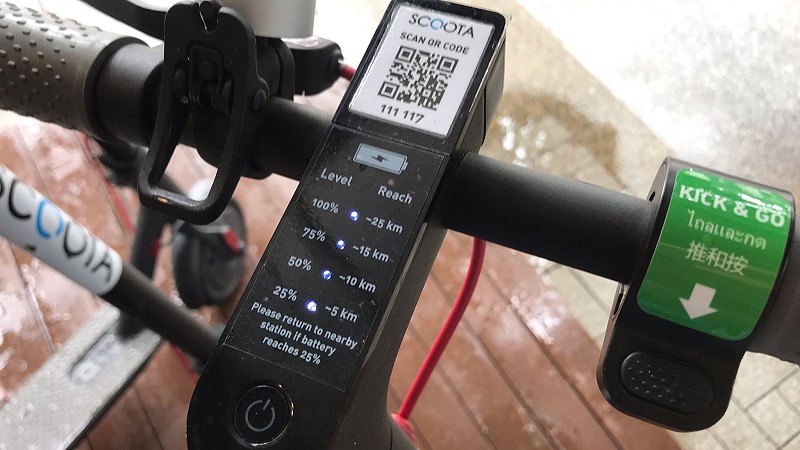
You can download the app for free on the Play Store and the Apple Store. You then register on the app with your email address. They then send you a one time password which you enter in the app. Next you choose your payment method. Finally, you scan the QR-CODE on the handlebar like in the above picture. Then, that’s it. The initial cost is 20 Baht and then it will cost you 2 Baht per minute. That might sound cheap, but it does add up. A thirty minute ride will cost you 80 Baht. To get around this, they suggest that you “clock out” at the nearest station to your destination and then explore that area on foot. Then, rent another e-scooter at your nearest station by scanning the QR-CODE. They are promising half day and full day rentals to make it cheaper, but there is no sign of that yet. In comparison, Neuron is the same 20 Baht to start up and then 3 Baht per minute. However, they already have rentals at 150 Baht for three days, 249 Baht for seven days and 599 Baht for 30 days. I will update the blog if anything changes. Also check out the comments below for comments and advice from other people.
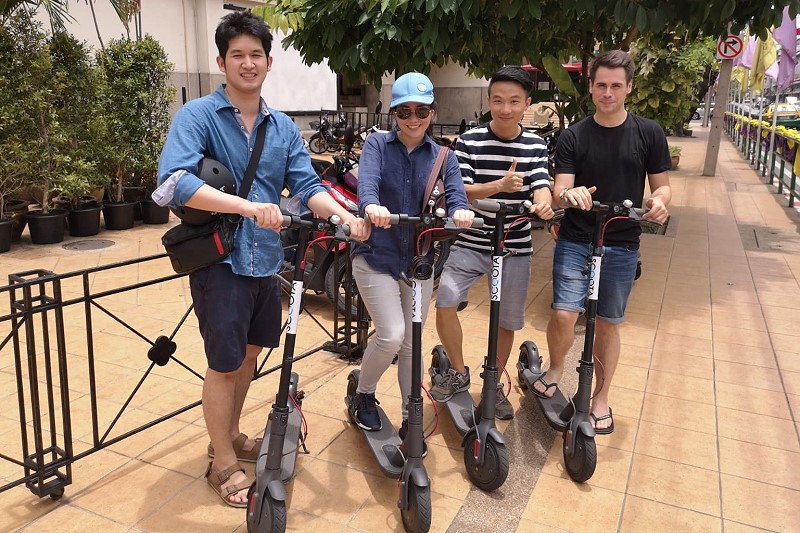
The electric kick scooter used by SCOOTA, and also the Go Scoot Bangkok tour that I went on last month (click here for a review), use the Xiaomi M365. These are easy to use and only weigh 12.7 kilos. It can reach a maximum speed of 25km/h and go as far as 30km. I am seriously thinking about buying the Pro version of this scooter which can be bought online for about 12,500-15,000 Baht. It is very easy to use. Just press the on/off button, place one foot on the scooter and push off with the other and then you are away. On the left handlebar, there is a brake and bell and on the right handside there is the throttle. There is no cruise control and so it is like a dead man’s switch. You take you thumb off it and it will come to a stop. In fact, I don’t use the dual brakes themselves unless it is an emergency situation. I just take my thumb off the throttle and let it glide to a stop. Or just jump off and walk. If you press the power button again, a headlight comes on at the front and a red light at the back. Double click the power button and it goes into eco mode. This doubles as beginner’s mode as it limits your speed. I should add here that unlike the tour I did last month with Go Scoot Bangkok, you are responsible for accident insurance. Make sure you read the fine print first!
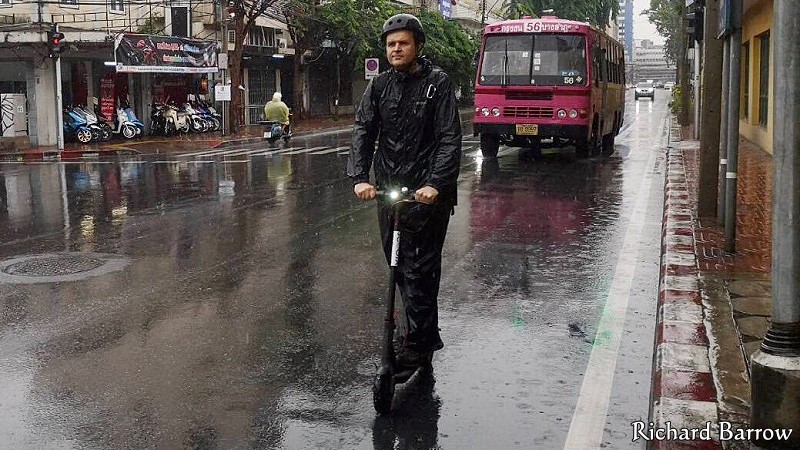
For my first test run with SCOOTA, I started at Cafe Velodome next to Sanam Luang with the intention of exploring Rattanakosin island. They have a number of stations in this area which means that you can rent as and when you desire. Unfortunately for me, the weather was awful during the test and so I didn’t get to explore any attractions in this area. However, I did get plenty of road experience in wet conditions. Luckily I had brought my wet weather gear and of course made sure that I wore a helmet. All of the scooters come with these and they are good quality, though a little on the small side for my large head. I was actually pleasantly surprised how well it handled in wet weather. Obviously electricity and water don’t mix but I didn’t experience any problems. I kept my speed down and avoided any flooded roads. The last thing I wanted to do was end up in a pot hole hidden in a pool of water. As the rain didn’t seem to want to stop, I decided to check out the MRT and ride on the underground train for a while.
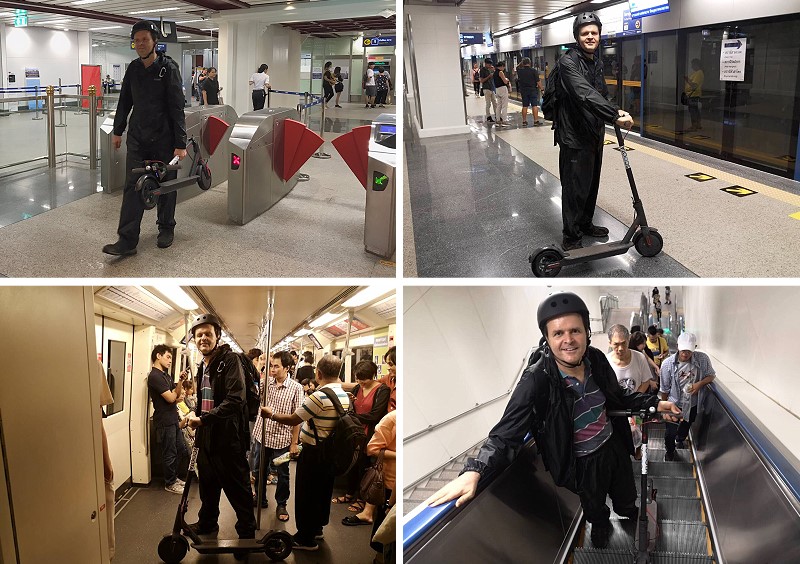
In the Rattanakosin area, there are two MRT stations. There is one at Sanam Chai and the other at Sam Yot. You are not allowed to take bicycles onto the underground train unless they are foldable. Luckily for me, the e-scooter folds down as you can see in the first picture. This is quick and easy to do and then you just carry it through the barriers and down the escalators to the platforms below. As there wasn’t that many people around, I decided to raise the handlebar again as it made it easier to push. And really, the footprint is no different with the handlebar folded down or up. However, if the carriage was really busy, I probably would need to fold it and then stand it up on its end. I don’t think I inconvenienced any other passengers. Certainly no more than those people with rucksacks or suitcases. Hopefully tour companies won’t bring their customers onto the train. This was what bike tours used to do on the skytrain which is probably one of the reasons why they banned bicycles during the day. At the moment not many people use e-scooters and so we are still a novelty.
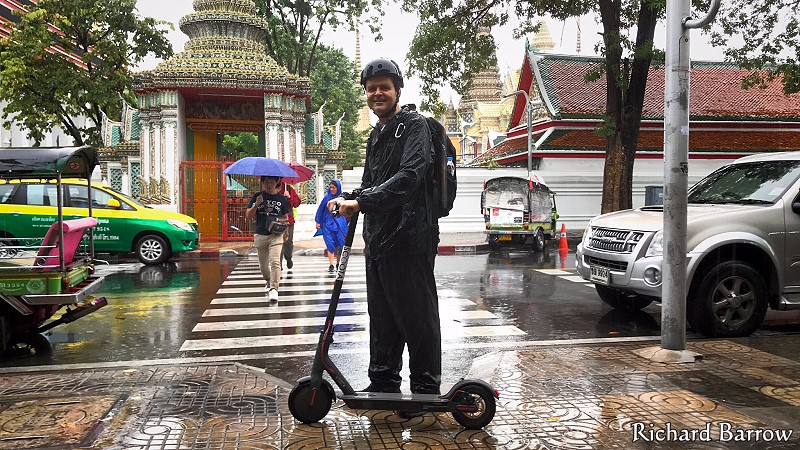
Despite the bad weather, the roads in this area were a lot smoother compared to the back roads that we took during the tour last month. Either that, or I was more used to the conditions and knew what to do over bumps in the road. My tour guide had told me to slightly bend my knees to lessen the impact. Like I mentioned in my last blog, one of my concerns was about safety. However, I feel really at home now on the electric kick scooter and in some ways it’s safer than on a bicycle or motorcycle. For a start, you are standing up and so you have a higher and clearer viewpoint. Secondly, to dismount, all you have to do is step off. So, in an emergency situation it is easier to get out of the way. I always ride the scooter by the side of the road and if I feel that it is getting too dangerous I just step off onto the curb and lift the scooter along with me without breaking my stride. Yes, there has been newspaper reports of people on scooters being hit by cars and buses. But so do pedestrians and cyclists. You can lower your chances of getting hit by not weaving in and out of traffic, not going the wrong way on the road and not going too fast for the conditions. And of course, always wear a helmet!
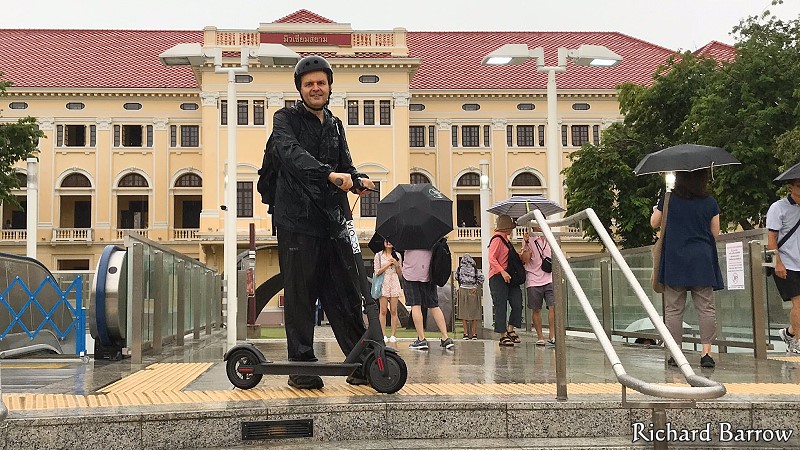
For my second trip on a SCOOTA, I explored Chinatown. I took it onto the skytrain as well as the underground with no problems. Someone who saw my live social media posts from Chinatown commented that they like to walk when they are exploring and so weren’t interested in the scooter. However, I found that I wasn’t riding the scooter that much during the trip. This is because I did quite a bit of walking. The thing about the scooter is that you can just step off at any time with no effort. With the bicycle, as you are sitting down all the time, and as you also need space to swing your leg to dismount, I found that I was lazy and spent most of my time on the bicycle. The SCOOTA also didn’t take up much room and so it was easier when pushing it through the markets. So, I enjoyed the combination of walking and then back onto the scooter when I wanted to explore some side streets. I have been to Chinatown many times, but during that one trip, I covered a much large area and found things I had never seen before. And, at the end of it all, I wasn’t really that tired.
If you want to learn more about SCOOTA, you can visit their website by clicking here. Even if you don’t want to rent from them, they offer spare parts and scooter care services. So, if your Xiaomi breaks down, they will fix it for you. Which is great as I heard that the tyres are not easy to change if they get a puncture. The above google map gives you an idea of the locations where you can now find SCOOTA. Initially they were mainly in the Rattanakosin island area of Bangkok. Now you can find them in Pattaya, Ayutthaya and Chiang Mai. Hopefully they will soon offer daily rentals which will make it cheaper to rent. I would also like to see the scooters have built in locks as I was always worried about security. For myself, I am still thinking about getting an electric kick scooter, I find them really good for getting around. It is doubtful that I will rent one. I will most likely buy one. But the problem is, which one? I am still thinking about the Xiaomi Pro but I will need to do a test ride first. It is slightly heavier than the one I have been using up to now and of course more expensive. I also have my eye on the Ninebot Max which has just been released. But this is a lot heavier and more than twice the price.
As usual, please leave your comments below. Please don’t link to newspaper articles saying how dangerous they are or about countries that now ban them. I have read all of the articles. If you haven’t already, please read Part One of this blog series about electric kick scooters. Hopefully, Part Three will be a test ride with the Xiaomi Pro, Part Four a comparison of the Xiaomi Pro and the Ninebot Max and for Part Five, I mighty finally have my own scooter!

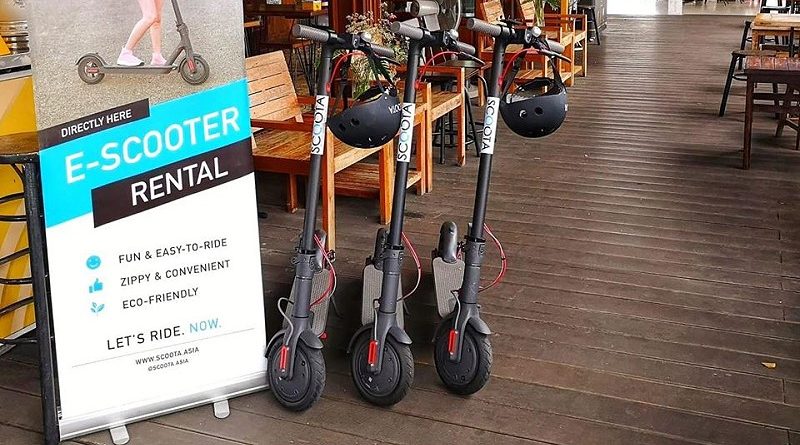

Great review and echoes many of the realistic user case scenarios presented to electric scooter users in bkk. Operate with caution, wear a helmet and dont get too confident no matter how effortlessly these gadgets move us around.
I bought a xaomi pro recently and its seems rock solid so far, i rode it from Bangna BTS to Asoke along Sukhumvit road. This was quite nerve wracking at first, because while the pro runs comfortably at 26 km per hr – we have to remember that the speed of traffic runs around 40km per hr + and especially after lights turn green. So it’s important to find an less obstructive position at the side of the road.
We can also drift onto the pavement ( when its clear ) and back onto the road at suitable opportunities.
Overall i think these things are great and hopefully Bangkok embraces them as a sensible and efficient mode of transit.